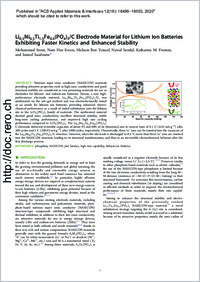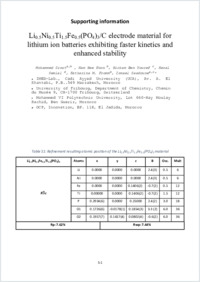Li0.5Ni0.5Ti1.5Fe0.5(PO4)3/C electrode material for lithium ion batteries exhibiting faster kinetics and enhanced stability
- Srout, Mohammed IMED-Lab., Cadi Ayyad University (UCA), Av. A. El Khattabi, P.B. 549, 40000 Marrakesh, Morocco - Department of Chemistry, University of Fribourg, Chemin du Musée 9, 1700 Fribourg, Switzerland
- Kwon, Nam Hee Department of Chemistry, University of Fribourg, Chemin du Musée 9, 1700 Fribourg, Switzerland
- Ben Youcef, Hicham Mohammed VI Polytechnic University, Lot 660-Hay Moulay Rachid, 43150 Ben Guerir, Morocco
- Semlal, Nawal OCP, Innovation, BP. 118, 24000 El Jadida, Morocco
- Fromm, Katharina M. Department of Chemistry, University of Fribourg, Chemin du Musée 9, 1700 Fribourg, Switzerland
- Saadoune, Ismael IMED-Lab., Cadi Ayyad University (UCA), Av. A. El Khattabi, P.B. 549, 40000 Marrakesh, Morocco - Mohammed VI Polytechnic University, Lot 660-Hay Moulay Rachid, 43150 Ben Guerir, Morocco
-
22.04.2020
Published in:
- ACS Applied Materials & Interfaces. - 2020, vol. 12, no. 16, p. 18496–18503
English
Natrium super ionic conductor (NASICON) materials providing attractive properties such as high ionic conductivity and good structural stability are considered as very promising materials for use as electrodes for lithium- and sodium-ion batteries. Herein, a new high-performance electrode material, Li0.5Ni0.5Ti1.5Fe0.5(PO4)3/C, was synthesized via the sol–gel method and was electrochemically tested as an anode for lithium ion batteries, providing enhanced electrochemical performance as a result of nickel substitution into the lithium site in the LiTi2(PO4)3 family of materials. The synthesized material showed good ionic conductivity, excellent structural stability, stable long-term cycling performance, and improved high rate cycling performance compared to LiTi2(PO4)3. The Li0.5Ni0.5Ti1.5Fe0.5(PO4)3/C electrode delivered reversible capacities of about 93 and 68% of its theoretical one at current rates of 0.1 C (6.42 mA·g–1) after 100 cycles and 5 C (320.93 mA·g–1) after 1000 cycles, respectively. Theoretically, three Li+ ions can be inserted into the vacancies of the Li0.5Ni0.5Ti1.5Fe0.5(PO4)3/C structure. However, when the electrode is discharged to 0.5 V, more than three Li+ ions are inserted into the NASICON structure, leading to its structural transformation, and thus to an irreversible electrochemical behavior after the first discharge process.
- Faculty
- Faculté des sciences et de médecine
- Department
- Département de Chimie
- Language
-
- English
- Classification
- Chemistry
- License
- License undefined
- Identifiers
-
- RERO DOC 328525
- DOI 10.1021/acsami.0c00712
- Persistent URL
- https://folia.unifr.ch/unifr/documents/308667
Other files
Statistics
Document views: 78
File downloads:
- fro_lem.pdf: 216
- fro_lem_sm.pdf: 106

